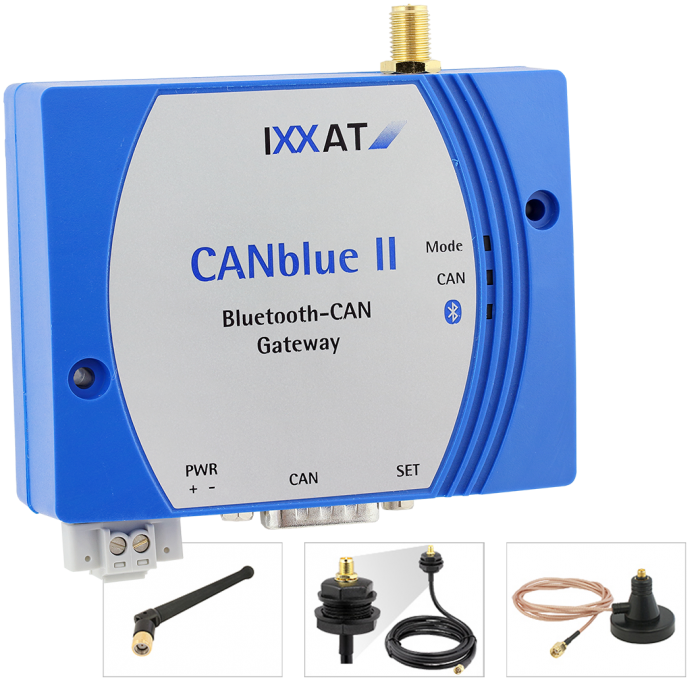We use cookies to make your experience better. To comply with the new e-Privacy directive, we need to ask for your consent to set the cookies. Learn more.
The CANblue II is a reasonably priced and versatile CAN Bluetooth module, which can be used in a wide range of applications due three supported operation modes.
For service applications it enables e.g. the wireless access to CAN systems using the standard Bluetooth interface provided within many notebooks. Due to this, diagnostic data can be read or system configuration tasks can be performed very simple and flexible, even at components which are hard to reach.
Using several CANblue II devices network segments can be networked among each other. This enables the reliable connection of rotating or moving parts, e.g. in wind turbines, as well as the bridging of larger distances between different sub-systems up to 200 meters. Failure-prone slip ring connections or expensive installations of large CAN lines can such be avoided.
Not least, the Bluetooth-based communication also offers significant advantages in terms of range and noise immunity, compared to traditional WLAN solutions.
How it works
Bridge mode
The bridge mode allows the user to set-up a CAN-Bluetooth-CAN bridge by using two CANblue II devices. Message exchange occurs on layer 2 and is transparent. The device can also be used in systems with CANopen, DeviceNet or customer-specific protocols. CAN-ID filters can be set for data exchange via Bluetooth. Using more than 2 CANblue devices, multiple busses can be linked with each other.
ASCII/Binary protocol mode
In this mode, functions for transmitting and receiving CAN messages and for configuring the CANblue II are available to the user based on simple ASCII commands and optimized CAN binary messages. The CANblue II is ideal for "non-Windows" systems or embedded platforms.
PC operation mode with VCI driver support
Because it is supported by the VCI CAN driver, the CANblue II can be operated with all IXXAT tools and with customer-specified programs. In addition, wireless access to CAN systems via Bluetooth can also be easily achieved with existing VCI-based application programs and tools.
Accessories
(for the CANblue II variant with external antenna)
• Antenna
• Magnetic foot antenna
• Screwable antenna foot
| Bluetooth interface | Bluetooth v4.0 with EDR, 200 m max. transmission range |
| Microcontroller | 32-bit microcontroller |
| CAN controller | CAN 2.0 A/B |
| CAN bus interface | ISO 11898-2, Sub D9 plug according to CiA 303-1 |
| Galvanic isolation | 1 kV, 1 sec. |
| Power Supply | 9 - 30 V DC, 0.6 W |
| Temperature range | -40 °C to +85 °C |
| Sending delay (average) | approx. 4 ms (in Shortest Latency Mode) |
| CAN performance at 1 Mbit | 100 % bus load |
| Certification | CE, FCC, Telec |
| Housing | Plastic housing with mounting holes |
| Protection Class | IP20 |
| Size | 82 x 64 x 26 mm |
• Quick start-up and connection
• High transmission range
• Low latency transmission and High data throughput
• Flexible configuration options (combination of several CANblue II)
| 1.01.0126.12000 | CANblue II - With internal antenna |
| 1.01.0126.12001 | CANblue II - For usage with external antenna (Antenna not included in the scope of delivery) |
| 1.04.0085.00001 | External antenna |
| 1.04.0085.00000 | Magnetic antenna foot with 1,5 m cable and RP-SMA connectors |
| 1.04.0085.00003 | Screwable antenna foot with 2 m cable and RP-SMA connectors |
Tecnologix offers support which is directly handled by development team. Do not hesitate to get in touch with our experts.
Just ask here



